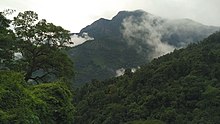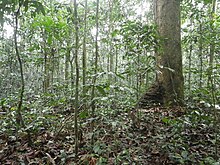
Tropical and subtropical moist broadleaf forests (TSMF), also known as tropical moist forest, is a subtropical and tropical forest habitat type defined by the World Wide Fund for Nature.
Description


TSMF is generally found in large, discontinuous patches centered on the equatorial belt and between the Tropic of Cancer and Tropic of Capricorn. TSMF are characterized by low variability in annual temperature and high levels of rainfall of more than 2,000 mm (79 in) annually. Forest composition is dominated by evergreen and semi-deciduous tree species.
These forests are home to more species than any other terrestrial ecosystem on Earth: Half of the world's species may live in these forests, where a square kilometer may be home to more than 1,000 tree species. These forests are found around the world, particularly in the Indo-Malayan Archipelago, the Amazon Basin, and the African Congo Basin.
The perpetually warm, wet climate makes these environments more productive than any other terrestrial environment on Earth and promotes explosive plant growth. A tree here may grow over 23 m (75 ft) in height in just 5 years. From above, the forest appears as an unending sea of green, broken only by occasional, taller "emergent" trees. These towering emergents are the realm of hornbills, toucans, and the harpy eagle.
Generally, biodiversity is highest in the forest canopy. The canopy can be divided into five layers: overstory canopy with emergent crowns, a medium layer of canopy, lower canopy, shrub level, and finally understory.
The canopy is home to many of the forest's animals, including apes and monkeys. Below the canopy, a lower understory hosts snakes and big cats. The forest floor, relatively clear of undergrowth due to the thick canopy above, is stalked by other animals such as gorillas and deer.
All levels of these forests contain an unparalleled diversity of invertebrate species, including New Guinea's stick insects and butterflies that can grow over 30 cm (1 ft) in length.
Many forests are being cleared for farmland, while others are subject to large-scale commercial logging. An area the size of Ireland is destroyed every few years.
Types
| This section needs additional citations for verification. Please help improve this article by adding citations to reliable sources in this section. Unsourced material may be challenged and removed. (March 2022) (Learn how and when to remove this message) |

The biome includes several types of forests:
- Lowland equatorial evergreen rain forests, commonly known as tropical rainforests, are forests which receive high rainfall (tropical rainforest climate with more than 2000 mm, or 80 inches, annually) throughout the year. These forests occur in a belt around the equator, with the largest areas in the Amazon basin of South America, the Congo Basin of central Africa, the Wet Tropics of Queensland in Australia and parts of the Malay Archipelago. About half of the world's tropical rainforests are in the South American countries of Brazil and Peru. Rainforests now cover less than 6% of Earth's land surface. Scientists estimate that more than half of all the world's plant and animal species live in tropical rainforests.
- Tropical seasonal forests, also known as moist deciduous, monsoon or semi-evergreen (mixed) seasonal forests, have a monsoon or wet savannah climates (as in the Köppen climate classification): receiving high overall rainfall with a warm summer wet season and (often) a cooler winter dry season. Some trees in these forests drop some or all of their leaves during the winter dry season. These forests are found in South Florida, parts of South America, in Central America and around the Caribbean, in coastal West Africa, parts of the Indian subcontinent, Northern Australia and across much of Indochina.
- Montane rain forests are found in cooler-climate mountainous areas. Those with elevations high enough to regularly encounter low-level cloud cover are known as cloud forests.
- Flooded forests, including freshwater swamp forests and peat swamp forests.
- Manigua a low, often impenetrable dense forest of tangled tropical shrub and small trees. It is usually found in marshy areas but also on dry land in certain places. The term is used in Cuba, the Dominican Republic, Puerto Rico and Colombia.
Notable ecoregions
A number of TSMF ecoregions are notable for their biodiversity and endemism:
- Southwest Amazon moist forests in Brazil, Peru and Bolivia
- Atlantic Forest in Brazil, Argentina and Paraguay
- Chocó–Darién moist forests in Colombia and Panama
- The Wet Tropics of Queensland in Australia
- Northwestern Andean montane forests of Colombia and Ecuador
- Guayanan Highlands moist forests
- Cuban moist forests
- Veracruz moist forests in Mexico
- Congolese rainforests
- Upper Guinean forests
- Albertine Rift montane forests from Uganda to Burundi
- Eastern Arc forests of Kenya and Tanzania
- Coastal forests of eastern Africa from Somalia to Mozambique
- Madagascar subhumid forests
- Puerto Rican moist forests
- Sri Lanka lowland rain forests
- Peninsular Malaysian peat swamp forests
- Borneo peat swamp forests
- New Caledonia rain forests
- Western Ghats
See also
- Tropical dry broadleaf forest
- Tropical coniferous forests
- Center for Tropical Forest Science (CTFS)
- International Tropical Timber Organization (ITTO)
- List of tropical and subtropical moist broadleaf forests ecoregions
- Monodominance
- Trees of the world
- Tropical vegetation
- Cloud forest
References
- ^
 This article incorporates text available under the CC BY-SA 3.0 license. World Wide Fund for Nature. "Tropical and Subtropical Moist Broadleaf Forest Ecoregions". Archived from the original on 2011-04-01. Retrieved 2019-05-29.
This article incorporates text available under the CC BY-SA 3.0 license. World Wide Fund for Nature. "Tropical and Subtropical Moist Broadleaf Forest Ecoregions". Archived from the original on 2011-04-01. Retrieved 2019-05-29.
- Basic Biology (2016). "Forest".
- Webb, Len (1 Oct 1959). "A Physiognomic Classification of Australian Rain Forests". Journal of Ecology. 47 (3). British Ecological Society : Journal of Ecology Vol. 47, No. 3, pp. 551-570: 551–570. Bibcode:1959JEcol..47..551W. doi:10.2307/2257290. JSTOR 2257290.
- Tracey, J. G. (John Geoffrey) (1982), The Vegetation of the Humid Tropical Region of North Queensland, pp. 13–20
- Tracey, J. G. (John Geoffrey) (1982), The Vegetation of the Humid Tropical Region of North Queensland, pp. 13–20
- Beard, J.S.; Keneally, K.F. (1987), 'Rainforests of Western Australia'. In 'The rainforest legacy: Australian national rainforests study'. Special Australian heritage publication series 7(1), pp. 289–304
- Webb, L. J. (Leonard James); Tracey, J. G. (John Geoffrey) (1982), An ecological survey of the monsoon forests of the north-western region of the Northern Territory, Australian National Parks and Wildlife Service
- Russell-Smith, Jeremy; Dunlop, Clyde (1987), The status of monsoon vine forests in the Northern Territory: a perspective. In 'The rainforest legacy: Australian national rainforests study. Special Australian heritage publication series 7(1)
- Stanton, J.P.; Fell, David. G. (2005). "The rainforests of Cape York Peninsula". Rainforest CRC – via National Library of Australia.
- Tracey, J. G. (John Geoffrey) (1982), The Vegetation of the Humid Tropical Region of North Queensland, pp. 34–38
- Tracey, J. G. (John Geoffrey) (1982), The Vegetation of the Humid Tropical Region of North Queensland, pp. 20–25
- Pichardo, Esteban. Diccionario provincial casi-razonado de vozes cubanas 3d ed. Havana 1861 p. 172
- Cámara Artigas, Rafael; Martínez Batlle, José Ramón; Díaz del Olmo, Fernando. Desarrollo sostenible y medio ambiente en República Dominicana: Medios naturales, manejo histórico, conservación y protección. Sevilla 2012. ISBN 84-00-08392-X, p. 169.
- Hernández Aquino, Luis (1993). Diccionario de voces indígenas de Puerto Rico. p. 330.
- Tracey, J. G. (John Geoffrey) (1982), The Vegetation of the Humid Tropical Region of North Queensland, pp. 13–70
- Terborgh, J; Winter, B (1983). "A method for siting parks and reserves with special reference to Colombia and Ecuador". Biological Conservation. 27 (1): 45–58. Bibcode:1983BCons..27...45T. doi:10.1016/0006-3207(83)90005-8.
- Whitmore, TC; Prance, GT, eds. (1987). Biogeography and Quaternary history in tropical America. Oxford Monographs on Biogeography. Oxford, UK: Clarendon Press.
- Borhidi, A (1991). Phytogeography and vegetation ecology of Cuba. Budapest, Hungary: Akadémiai Kiadó.
- Kingdon, J (1997). African mammals. San Diego, California, USA: Academic Press. ISBN 9780124083554.
- Review of the protected areas system in the Afrotropical Realm. Gland, Switzerland: IUCN/UNEP. 1986a.
- Kingdon, J (1989). Island Africa: the evolution of Africa's rare animals and plants. Princeton, New Jersey, USA: Princeton University Press.
- Hamilton, AC; Bensted-Smith, R (1989). Forest conservation in the East Usambara Mountains, Tanzania. Gland, Switzerland: IUCN.
- Lovett, JC; Wasser, SK, eds. (1993). Biogeography and ecology of the rain forests of eastern Africa. Cambridge, UK: Cambridge University Press.
- Preston-Mafham, K (1991). Madagascar: A natural history. Oxford, UK: Facts on File.
- World Wildlife Fund, ed. (2001). "Puerto Rican moist forests". WildWorld Ecoregion Profile. National Geographic Society. Archived from the original on 2010-03-08. Retrieved 2010-11-17.
- Mittermeier, R.A.; Werner, T.B.; Lees, A. (1996). "New Caledonia – a conservation imperative for an ancient land". Oryx. 30 (2): 104–112. doi:10.1017/s0030605300021487.
External links
- Facts about the world's tropical rainforests from The Nature Conservancy
- NASA picture of the afforestation of the earth in the year 2002
- BBC video clips and details of the species found here
| Biogeographic regionalisations | |||||||||||||||||
|---|---|---|---|---|---|---|---|---|---|---|---|---|---|---|---|---|---|
| Biomes |
| ||||||||||||||||
| Biogeographic realms |
| ||||||||||||||||
| See also | |||||||||||||||||
Lua error in Module:Navbox at line 192: attempt to concatenate field 'argHash' (a nil value).
Categories: